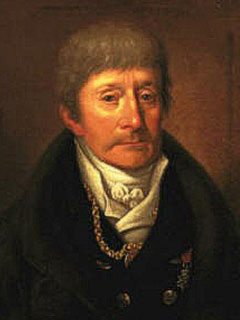The 18th century is the Age of Enlightenment. The individual, using his mind and critical judgment, reaches a state of independence and maturity. The Enlightenment ends the old social order and leads to new ideas of human dignity, freedom and happiness. In opposition to the Baroque lifestyle, its grandiloquence, pathos and ceremonial, a longing for the simple and natural arises. Now is the time of Rousseau’s idealistic return to an original state of nature in virtue and freedom. „Nature“ that was also the antiquity, where all human ideals were believed to be realized, the art of antiquity was called “classical”. Classical means in general exemplary, true, beautiful, full of harmony as well as simple and understandable. The focus of interest is, amongst other topics, the education of man, the role of the people, the genius in man.
 Antonio Salieri
Antonio Salieri
18 August 1750 – 7 May 1825
In the history of music the classical epoch is the time and the style of the three important Viennese masters Haydn, Mozart and Beethoven (Viennese Classicism). The term is first used shortly after Beethoven’s death, inspired by the perfection of the compositional technique, the high humanitarian content and the idealistic beauty, especially apparent in the music of Mozart. The forces of feeling and intelligence, of content and form are balanced in art. If mind and breath found their way into music during the Renaissance and during the Baroque era the affects of the human being, thus in the classical period enter his action, his gestures, his proving in the moment, vivid feelings and alert mind, well-balanced by an intuitive wholeness.
A new bourgeois music culture evolves in which a musician must assert himself as an independent artist, with private drawing room concerts, public concerts and opera, an anonymous audience, publishers and music criticism.
A climax is the year 1781: Haydn creates some of his groundbreaking works (for example the string quartet op. 33), Mozart’s Il Seraglio is performed, Schiller’s The Robbers and Kant’s Critique of Pure Reason are published.
Decisively new is the idea of the self-legality of music and art, which now not only describe nature, entertain and educate, but are also expected to express pure humanity with the help of an understandable and simple figurative language. The classical period strives for a supranational music as a universal language.
The character of music is no more solemn and grave but sanguine and uplifting. For the first time music is determined by an imaginary melody, freed of empty rhetorical phrases, as well as a dualistic, dramatic development, which evolves in the classical sonata form as a unity of contradicting motives and themes. With the works of Haydn, Beethoven and Mozart as model the sonata form becomes the only accepted form for the piano sonata, the sonata for a solo instrument with piano, the trio, quartet, quintet, the symphony, first not strictly separated from chamber music, and the prevalent three-movement concert, where violin and piano concerts prevail. Divertimento, cassation and serenade emerge as new genres.